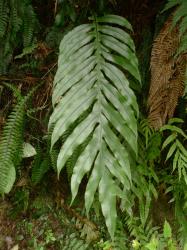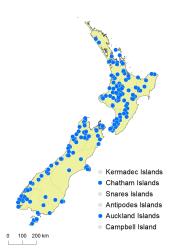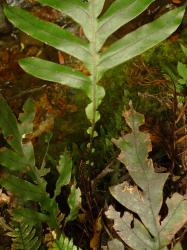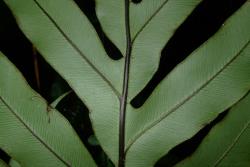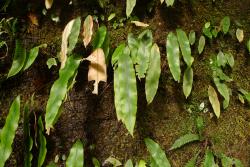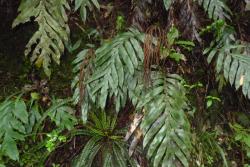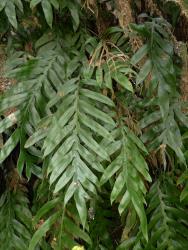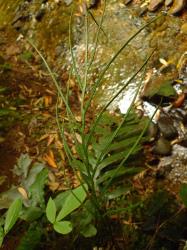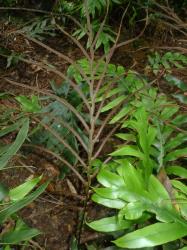- ≡ Lomaria colensoi Hook.f. in Hooker, Icon. Pl. 7, t. 627, 628 (1844)
- ≡ Austroblechnum colensoi (Hook.f.) Gasper & V.A.O.Dittrich in Dittrich et al., Phytotaxa 292: 72 (2017)
- = Lomaria heterophylla Colenso, Tasmanian J. Nat. Sci. 2: 175 (1845) nom. illeg., non Lomaria heterophylla Desv. 1811
Rhizomes short-creeping, up to 250 mm long (in herbarium material), bearing scales. Rhizome scales ovate or triangular, 6–11 mm long, 1.5–4 mm wide, bicolorous with dark brown centres and chestnut-brown margins. Fronds strongly dimorphic; fertile and sterile fronds with similar habit, often hanging downwards; pinnatifid sterile fronds 225–1270 mm long; fertile fronds on same plant about the same length, 270–900 mm long. Sterile fronds. Stipes 30–220 mm long, red-brown, bearing a few scales proximally. Rachises red-brown abaxially, yellow-brown and grooved adaxially, glabrous. Laminae either entire, narrowly elliptic, 70–380 mm long, 25–60 mm wide, or pinnatifid to pinnatisect, obovate, 190–1000 mm long, 70–440 mm wide, dark green adaxially, paler green abaxially, coriaceous, glabrous. Pinnae in 1–11 large pairs below a large acuminate terminal segment, closely spaced, oblong or narrowly elliptic or narrowly obovate, straight, reducing abruptly to several additional pairs of tiny sterile flanges at the lamina base; the longest pinnae at or above the middle, 60–290 mm long, 15–45 mm wide, apices acuminate, margins entire, bases decurrent; the basal pinnae alternate. Veins free. Fertile fronds. Stipes 50–210 mm long. Laminae 200–740 mm long, 90–280 mm wide. Fertile pinnae in 2–10 large pairs, linear, straight, the longest 85–280 mm long, 2–6 mm wide, reducing abruptly to several additional pairs of tiny sterile flanges at the lamina base. Sori and indusia in one row either side of costa, continuous along the length of the pinna, sometimes with green lamina tissue at base of pinnae in largest fronds.
Blechnum colensoi is distinguished by its strongly dimorphic fronds, free veins, pinnatisect sterile laminae, and continuous sori. The sterile laminae are glabrous, obovate, dark green on the adaxial surface but paler abaxially, divided into 1–11 pairs of very broad, decurrent pinnae in the distal half and several pairs of tiny flanges proximally. The sterile fronds contrast markedly with the fertile fronds, which have very narrow pinnae. The sterile fronds are sometimes entire in juvenile plants. B. colensoi is a plant of dark, wet habitats and the laminae are often covered in epiphyllous bryophytes.
North Island: Northland, Auckland, Volcanic Plateau, Gisborne, Taranaki, Southern North Island.
South Island: Western Nelson, Sounds-Nelson, Marlborough, Westland, Canterbury, Otago, Southland, Fiordland.
Chatham Islands, Stewart Island, Auckland Islands.
Altitudinal range: 10–1150 m.
In the North Island Blechnum colensoi occurs in lowland to montane forest from the Hokianga Harbour to Wellington, but is absent from most of the east coast. It grows from 10 m, up to 1150 m on Mt Taranaki, but is rare below 250 m. In the South Island it is widespread in lowland and montane areas west of the main divide, but has a much more scattered distribution in eastern districts. It grows from near sea level in Fiordland to over 750 m in the St Arnaud Range, near Lake Monowai and at Blue Duck Reserve, Marlborough. It extends to the Chatham Islands, Stewart Island and the Auckland Islands.
Blechnum colensoi is a terrestrial fern found under podocarp, broadleaved and beech forest, usually in damp, shaded habitats. It grows on rock walls, steep-sided gullies, stream banks, track banks, on the forest floor, and sometimes on shingle slips. It is frequently found hanging from steep banks close to waterfalls.
2n = 122 (Murray & de Lange 2013).
This species was misidentified in several earlier New Zealand Floras as Lomaria elongata Blume, Lomaria patersonii (R.Br.) Spreng. or Blechnum patersonii (R.Br.) Mett.



